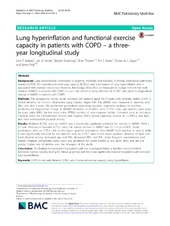| dc.Published | Aalstad, Hardie JA, Espehaug B, Thorsen E, Bakke PS, Eagan TML, Frisk BF. Lung hyperinflation and functional exercise capacity in patients with COPD - a three-year longitudinal study. BMC Pulmonary Medicine. 2018;18:187 | eng |
| dc.description.abstract | Background: Lung hyperinflation contributes to dyspnea, morbidity and mortality in chronic obstructive pulmonary disease (COPD). The inspiratory-to-total lung capacity (IC/TLC) ratio is a measure of lung hyperinflation and is associated with exercise intolerance. However, knowledge of its effect on longitudinal change in the 6-min walk distance (6MWD) in patients with COPD is scarce. We aimed to study whether the IC/TLC ratio predicts longitudinal change in 6MWD in patients with COPD. Methods: This prospective cohort study included 389 patients aged 40–75 years with clinically stable COPD in Global Initiative for Chronic Obstructive Lung Disease stages II-IV. The 6MWD was measured at baseline, and after one and 3 years. We performed generalized estimating equation regression analyses to examine predictors for longitudinal change in 6MWD. Predictors at baseline were: IC/TLC ratio, age, gender, pack years, fat mass index (FMI), fat-free mass index (FFMI), number of exacerbations within 12 months prior to inclusion, Charlson index for comorbidities, forced vital capacity (FVC), forced expiratory volume in 1 s (FEV1), and light and hard self-reported physical activity. Results: Reduced IC/TLC ratio (p < 0.001) was a statistically significant predictor for decline in 6MWD. With a 0.1-unit decrease in baseline IC/TLC ratio, the annual decline in 6MWD was 12.7 m (p < 0.001). Study participants with an IC/TLC ratio in the upper quartiles maintained their 6MWD from baseline to year 3, while it was significantly reduced for the patients with an IC/TLC ratio in the lower quartiles. Absence of light and hard physical activity, increased age and FMI, decreased FEV1 and FVC, more frequent exacerbations and higher Charlson comorbidity index were also predictors for lower 6MWD at any given time, but did not predict higher rate of decline over the timespan of the study. Conclusion: Our findings demonstrated that patients with less lung hyperinflation at baseline maintained their functional exercise capacity during the follow-up period, and that it was significantly reduced for patients with increased lung hyperinflation. | en_US |

